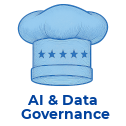Governance Failure Pattern #3: AI Governance as an Afterthought
AI models are deployed.
Decisions are made.
Customers are impacted.
And only then does someone ask:
- Who owns the training data?
- What controls exist around drift and bias?
- How do we explain this model to regulators or customers?
This is the third governance failure pattern:
AI Governance as an Afterthought.
The Reactive Trap
In many organizations, governance only enters the conversation after something goes wrong:
- A biased model triggers public backlash
- A regulator demands documentation
- A customer asks for an explanation, and no one has one
Governance becomes a bolt-on.
A compliance scramble.
A risk mitigation exercise.
But by then, the damage is done.
Real-World Consequences
Let’s look at a few examples:
1. Apple Card Bias Allegation
In 2019, Apple’s credit card algorithm was accused of giving women lower credit limits than men with similar financial profiles.
The issue? A lack of transparency and explainability.
Even though regulators found no intentional bias, the reputational damage was real.
2. Air Canada’s Chatbot Blunder
In 2024, a customer relied on an AI chatbot’s advice to book a bereavement fare, only to be denied the discount later.
The court ruled that Air Canada was responsible for the chatbot’s output.
The problem wasn’t the tech, it was the lack of governance around it.
3. Paramount’s Data Misuse Lawsuit
A 2024 class-action suit alleged that Paramount’s AI-powered recommendation engine shared subscriber data without proper consent.
The root cause? No clear data lineage or consent governance.
These aren’t edge cases.
They’re symptoms of a broader pattern: deploying AI without embedding governance into the lifecycle.
Why This Happens
- AI teams are incentivized to ship fast
- Governance teams are seen as blockers
- Compliance is reactive, not proactive
- Business leaders assume “someone else” is handling it
The result?
Models go live before anyone defines ownership, accountability, or oversight.
What to Do Instead: Embed Governance into the Lifecycle
Governance must be designed into every phase of the AI journey:
| Phase | Governance Action |
| Design | Define data ownership, consent, and intended use |
| Development | Track lineage, document assumptions, test for bias |
| Deployment | Establish controls for drift, access, and explainability |
| Monitoring | Continuously audit performance, fairness, and compliance |
This isn’t just risk management, it’s strategic enablement.
As the Responsible AI Institute puts it:
“AI governance isn’t a checkbox, it’s a business imperative.”
Tools That Help
5 Star AI & Data Governance outlines several frameworks that clarify:
- Role activation (who owns what)
- Lifecycle checkpoints
- Documentation templates
- Drift and bias monitoring workflows
These aren’t theoretical; they’re designed for real teams, real models, and real accountability.
Final Thought: Governance Isn’t a Patch. It’s a Pattern.
If governance only shows up after deployment, it’s already too late.
The goal isn’t to slow down innovation; it’s to make it sustainable, explainable, and trustworthy.
So before your next model goes live, ask:
“Is this system ready to be governed?”
Because in the age of AI, oversight isn’t optional.
It’s the difference between acceleration and accountability.

